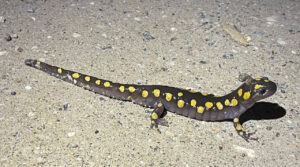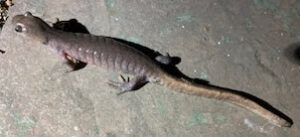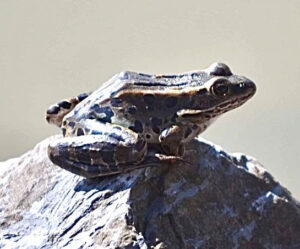Herp Update: Amphibian Migration, Vernal Pools – April 3, 2024
Herp Activity
Amphibian Migration Continues in Fits and Starts
Herpers, since our first significant amphibian migration almost one month ago on March 5, winter has returned and left a couple times. I don’t think that the temperatures ever got cold enough to kill the amphibians that moved early. I hope they are hunkered down under some cover object waiting for another warm and wet night.
Clearly some frogs made it to their breeding pools. We have had reports of Wood Frogs calling in Addison, Charlotte, Cornwall, Fair Haven, Ferrisburgh, Grand Isle, Hinesburg, Middlebury, New Haven, Northfield, Orwell, Proctor, Rockingham, Salisbury, Shelburne, and Springfield. A couple of these have been reports of full choruses. Most of these are Lake Champlain Basin towns, but we were surprised to also get a report of Wood Frogs calling in Derby, way up in the Northeast Kingdom. Walter Medwid reported these to us. He keeps us up-to-date on herp activity in the NEK.
I suspect that many of these Wood Frogs actually moved in full daylight. We have seen that happen before when the few Wood Frogs that reached their breeding pools during the night, started calling on a warm, sunny, spring afternoon. This is apparently too much for nearby Wood Frogs hiding in the leaf litter to resist. As a result, they move mid-day so they don’t miss a breeding opportunity. We have occasionally been able to hear multiple Wood Frogs moving to ponds as they hopped through dry leaves in full sunlight.
Spring Peepers have also been reported calling from most of the same towns (including Derby) but these were not full choruses. The Spring Peeper reports coming in are of just a few individuals. It appears that most of them have not yet moved.
Other amphibians reported recently have been Blue-spotted Group Salamanders in Ferrisburgh, Grand Isle, and Salisbury. David Hoag found some Blue-spotted Group eggs in a pool in Grand Isle. Pure Blue-spotteds lay single eggs on the bottoms of ponds and pools. Hybrids in the Blue-spotted Group lay small groups of a few eggs in a cluster.
Spotted Salamanders have been reported from Monkton, Proctor, Rutland, Salisbury, Shaftsbury, and Shelburne.
A single Jefferson Salamander was photographed on the move in Poultney. I suspect Jeffs have moved in other locations as well, but we have far fewer populations of this species than the other two mole salamanders so we don’t get very many reports.
Helen Linda visited Dead Creek in Addison on the warm afternoon of March 31 and reported an impressive variety of herps: Painted Turtle, Green Frog, Wood Frogs, and Common Gartersnakes (in a breeding ball). David Guertin was there on the same day and added an American Bullfrog to the list. Keep in mind that the American Bullfrog, Green Frog, and Painted Turtle were not migrating. They only had to rise to the surface of the pond where they had spent the winter, and the Common Gartersnakes mate just as they leave the den, so the mating ball that Helen Linda saw was probably only a few feet from where they spent the winter. Another Common Gartersnake was reported out and about in Shoreham. Hopefully, the snakes went right back in their den when temperatures started to drop.
Northern Leopard Frogs migrate from deep water to floodlands very early in spring. They have only been reported twice so far this spring. One was seen by my wife Kris in Cornwall and the other was photographed in Ferrisburgh by Santa Andujar.
Wood Turtles continue to be seen basking on warm sunny afternoons along the banks of the rivers where they spent the winter.
Upcoming Activity
I expect there will be amphibian migration early this evening in parts of Vermont where the rain continues into the evening before it changes to snow. If you are tempted to get out, be very careful of the strong winds and mixed precipitation. There should be more productive and safer opportunities to see amphibian migration coming up in next few weeks.
Help Needed Checking One or Two Vernal Pools
Using the Jefferson Salamander reports in our database, Tufts graduate student Jess Zulch has analyzed forest cover, habitat type, distance to breeding pools, buffering capacity of the soils, and elevation, to predict 14 additional pools where Jefferson Salamanders should be found, but have not been reported. She could use some volunteers to visit her selected pools later this month to check for Jeff egg masses. She has prepared materials on identifying egg masses and could use a few volunteers willing to check one or two pools near their homes. If you have any interest in checking a couple pools for her, please contact her directly to learn the locations of the priority pools and get her materials. Her e-mail is Jessica.Zulch@tufts.edu.
Photos
Antioch New England graduate student Rosy Metcalfe photographed a pair of courting Eastern Newts from a pond near her home in Waterbury. The top photo clearly shows how the males use their flattened tails to waft their pheromones into the faces of the females. Notice how much darker the male is than the female. This is usually the case. Males also have flattened fish-like tails and the females do not. Although some newts do migrate, I strongly suspect that these two spent the winter in her pond. Eastern Newts lay single eggs attached to vegetation.

Salisbury herpers and herp caretakers Brian Carter and Leah Farrell visited Morgan Road in Salisbury on March 27th and took this photo of a beautiful adult Spotted Salamander crossing the road into the Leicester River swamp.

Tom Mauhs-Pugh photographed this female Jefferson Salamander (Group) in Poultney.

The bottom photo is of the Northern Leopard Frog Santa Andujar saw in Ferrisburgh.


